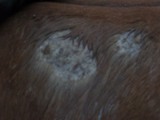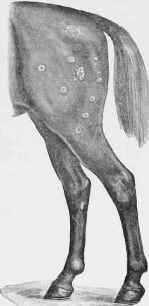 Ringworm (dermatophytosis) is due to a fungal skin infection (dermatophyte) rather than worms. The fungal species responsible are Microsporum and Trichophyton spp. This disease is highly contagious between horses with young horses, geriatric horses, debilitated and immunocompromised horses being the most severely affected. Usually the whole stable is infected.
Ringworm (dermatophytosis) is due to a fungal skin infection (dermatophyte) rather than worms. The fungal species responsible are Microsporum and Trichophyton spp. This disease is highly contagious between horses with young horses, geriatric horses, debilitated and immunocompromised horses being the most severely affected. Usually the whole stable is infected.
It is generally introduced by a new horse entering the stable and spread mainly through grooming equipment, tack and rugs. Therefore, racehorses and other horses that share equipment are most commonly affected. Fungi can live on the skin for up to three weeks before horses develop clinical signs of disease. Multiple horses are rapidly affected as gear is shared between apparently clean horses. The disease is worse in hot, humid weather. The fungi can survive for prolonged periods in the environment, mainly on girths, saddlecloths, rugs and headcollars. Horses can also spread the disease to humans. Infection eventually produces immunity.
Lesions typically start as small raised spots and rapidly progresses to extensive circular areas of hairloss and “dandruff”. Horses are usually most affected around the girth, saddle area and face. Horses are not usually itchy or painful as a result of these lesions. However, horses are susceptible to secondary bacterial infections which may become painful. If there is any doubt your vet can perform skin scrapings and cultures to confirm the diagnosis. However, fungi do take a long time to grow in the laboratory and the disease is usually successfully treated by the time that results are received.
 Treatment should be initiated immediately as soon as any horse in the stable shows signs of infection. Any delay can result in rapid spread and extensive lesions. Once the condition takes hold it is very aggressive. The first step is to disinfect all tack. Girths, covers, saddlecloths, headcollars, bridles, grooming equipment and rugs should be all washed in a suitable disinfectant such as iodine or bleach. PVC gear is much easier to disinfect thoroughly. Although often not practical, if it is possible to have separate gear for each horse this is ideal. In the least, separate gear for affected and non-affected horses is recommended. Remember that horses without apparent lesions can still be incubating fungi and are still potentially infectious. Staff should wear disposable gloves when dealing with infected horses, and ideally these horses should be handled and exercised last.
Treatment should be initiated immediately as soon as any horse in the stable shows signs of infection. Any delay can result in rapid spread and extensive lesions. Once the condition takes hold it is very aggressive. The first step is to disinfect all tack. Girths, covers, saddlecloths, headcollars, bridles, grooming equipment and rugs should be all washed in a suitable disinfectant such as iodine or bleach. PVC gear is much easier to disinfect thoroughly. Although often not practical, if it is possible to have separate gear for each horse this is ideal. In the least, separate gear for affected and non-affected horses is recommended. Remember that horses without apparent lesions can still be incubating fungi and are still potentially infectious. Staff should wear disposable gloves when dealing with infected horses, and ideally these horses should be handled and exercised last.
Horses should be washed daily for at least a week with an iodine or chlorhexidine shampoo. Products also containing miconazole, eg malaseb are recommended. It is important to thoroughly massage the shampoo into the skin and remove the dandruff and scurf. The shampoo should be left on for 10-15 minutes, then rinsed off and the horse dried with a clean towel. The frequency of shampooing can then be decreased to 1-3 times per week until the lesions have all healed. Dilute iodine or miconazole cream can be spotted on the worst of the lesions. However, be careful of stronger iodine products as these will irritate and blister the skin, increase susceptibility to secondary infection of the damaged skin and cause the hair to grow back white. If a satisfactory result is not obtained consult your veterinarian as no single treatment is effective on every horse.
Human infections generally appear as raised, itchy, sometimes painful circular lesions. These lesions are contagious to other humans and horses. Medical treatment should be sought from your doctor.










